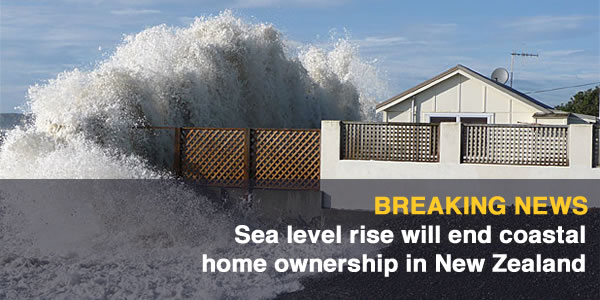A new report from the Parliamentary Commissioner for the Environment (PCE) Jan Wright released today highlights the perilous status of our national institution – the seaside bach or crib. The PCE’s report is a summary of the state of the science around anthropogenic climate change as outlined in recent IPCC reports, with a focus on sea level rise. The report looks at the state of the science via a New Zealand-centred lens. Sea level rise is happening and it will impact coastal properties and roads during our lifetime. It is no longer to be seen as a problem for the never, never.
Government, local Councils, insurers, banks, in fact everyone needs to start thinking about how we each will deal with this problem, because it is not going away. Because it’s predictable the insurance industry is already on the bus, ramping up insurance premiums.
How much sea level rise?
Like the consensus science behind the IPCC reports it is based on, the Commissioner’s report makes for depressing reading, cataloguing the amount of water trapped in ice sheets in Greenland and Antarctica. If we kept burning fossil fuels and it all melted, we would eventually be looking at 64 metres of sea level rise.
However, we will only see a tiny proportion of this melting during our lifetime. Sea levels have risen by 20cm over the past century, and best estimates suggest we will see a rise of 30cm more by mid this century. So the rate of rise is increasing and depending on how quickly if at all, humankind stops chugging through coal and oil, that number could be up to 1m by the end of the century.
Extreme events remain the main threat for now
Thirty centimetres doesn’t sound like much, that probably only requires the sort of wall that most children will build in a day if given sand, a spade and bucket. Sadly, walls are a complete waste of time, as they totally underestimate the scale of the problem we face. We don’t have to worry about the 30cm, we have to worry about extreme events.
Each centimetre of sea level rise also raises the water table, making the land more vulnerable to flood. And during a storm, the impact of sea level rise is amplified by stronger winds and bigger waves, especially if they coincide with a king tide. All this increases the risk of extreme events swamping our coastal baches and roads, extreme events that are only more likely to happen in the changing climate of the future.
Take the storm that hit Auckland in 2011 (see video below) – flooding the motorway and overloading drains. In thirty years time, we can expect this level of flooding every ten years. A few decades later, every year. At what point do we abandon some parts of the country because it becomes too expensive to rebuild the roads, repair the seawalls or salvage the houses?
Who pays?
The Christchurch earthquake was nasty and it created an expectation that government will step in and save us in the event of a catastrophic disaster. However, this is unlikely to be the case for sea level rise, for a couple of reasons. Firstly, it is completely predictable – only people with their head in the sand won’t see it or deny it’s coming and follow that through by not insuring or being prepared. Taking such an incredulous position will make it harder for coastal property owners to receive a sympathetic hearing when they come groveling to the taxpayer to restitute them because their precious bach is rendered unliveable. Secondly, given the amount of coastal property, its value, and the fact that sea level rise is unlikely to stop happening any time soon, the total bill is completely unaffordable even if the government of the day wanted to apply taxpayers funds to compensation. Seawalls are pointless for exactly the same reason. You can’t beat sea level rise – you just have to go with the flow.
The Insurance Council of New Zealand can see the writing on the wall – they have released a report calling for government action to coordinate national responses to disasters, amend the Resource Management Act to stop development in dodgy areas and to ensure all natural hazards are listed on property LIM (Land Information Memorandum) reports. The Chief Executive of the Insurance Council is under no illusions to the risks we face:
“Climate change will increase the risk of flooding in parts of the country and drought in other areas… Coastal areas will be more vulnerable as sea levels rise and we can expect more severe windstorms in the west.”
Government needs to act now
Some councils, such as Kapiti, have dared put their head above the seawall and tried to restrict development in areas that are prone to sea level rise. They ended up being taken to court by the landowners whose property values were being put at risk. Other councils are calling for more leadership from central government to help them do the right thing. But this particular potato is too hot for the government to touch, way too hot.
Unless they act now, many will end up paying dearly. All we know is that it won’t be the insurance industry – they will be long gone by the time the risk is obvious to even the most obtuse. They are already preparing their escape routes. It will be left to banks, property owners, or more likely ratepayers and taxpayers, to argue how much if at all they will contribute to bailing people out of what is a completely predictable natural disaster.
Our advice to coastal property owners is to accept the inevitable and either write off an increasing proportion of your seaside treasure, or if you’re not prepared to do that, move out.

